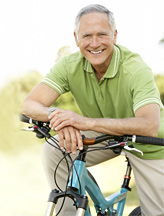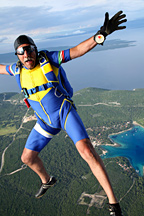Age Is Just a Number
By Drs. Ronald Klatz and Robert Goldman
You lose about half of your muscle mass between the ages of 30 and 80. This natural consequence of aging reduces strength, slows metabolism, degrades key body functions such as cardiovascular performance and bone health, and can compromise longevity. What can you do about it - whether you're 30 or 80 - to make sure you're as healthy as possible for as long as possible?
Stay active.
Not only can physical activity make the difference between becoming decrepit or staying fit and vital, it has now been identified as a major factor contributing directly to how long we can live. For example, Jeremy M. Jacobs, from Hebrew University Hadassah Medical School (Jerusalem, Israel), and colleagues examined the effects of continuing, increasing or decreasing physical activity on levels on survival, function and health status among the very old.
 In their study involving 1,861 men and women, 70 to 88 years of age, and lasting for 18 years, the researchers found that elderly men and women who are physically active (four or more hours of physical activity per day) increase their chances of living longer and maintaining functional independence compared to their sedentary peers (less than four hours of physical activity daily). Among active 70-year-olds, the team found that only 15 percent died over the next eight years (pretty good, considering their age), compared to 27 percent of sedentary 70-year-olds. The differences were progressively more pronounced the older people got: Eight-year mortality was 26 percent for active 78-year-olds and 41 percent for sedentary peers; and among 85-year-olds, three-year mortality was roughly 7 percent for active individuals as compared to 24 percent for sedentary counterparts.
In their study involving 1,861 men and women, 70 to 88 years of age, and lasting for 18 years, the researchers found that elderly men and women who are physically active (four or more hours of physical activity per day) increase their chances of living longer and maintaining functional independence compared to their sedentary peers (less than four hours of physical activity daily). Among active 70-year-olds, the team found that only 15 percent died over the next eight years (pretty good, considering their age), compared to 27 percent of sedentary 70-year-olds. The differences were progressively more pronounced the older people got: Eight-year mortality was 26 percent for active 78-year-olds and 41 percent for sedentary peers; and among 85-year-olds, three-year mortality was roughly 7 percent for active individuals as compared to 24 percent for sedentary counterparts.
Not convinced yet? After all, four hours of physical activity daily may sound like quite a challenge. Well, here are a few other studies that suggest staying consistently active can contribute to a longer, better, healthier life.
Don't Lose Your Intensity
 Another study suggests sedentary elderly men are at a markedly increased risk of dying compared to men who engage in regular physical activity. Peter Kokkinos, from the Veterans Affairs Medical Center in Washington, D.C., and colleagues studied 3,041 male veterans (ages 70 to 92), tracking all-cause mortality (death) for more than 20 years. At the start of the study, participants completed a treadmill exercise test, after which each subject was categorized into one of four fitness categories based on peak metabolic equivalent (MET) achieved. (MET is essentially a quantification of the intensity and energy expenditure of physical activities; the higher the MET, the more intense the exercise. If you have a higher peak MET, it generally means you're capable of performing more intense physical activity than someone with a lower peak MET.)
Another study suggests sedentary elderly men are at a markedly increased risk of dying compared to men who engage in regular physical activity. Peter Kokkinos, from the Veterans Affairs Medical Center in Washington, D.C., and colleagues studied 3,041 male veterans (ages 70 to 92), tracking all-cause mortality (death) for more than 20 years. At the start of the study, participants completed a treadmill exercise test, after which each subject was categorized into one of four fitness categories based on peak metabolic equivalent (MET) achieved. (MET is essentially a quantification of the intensity and energy expenditure of physical activities; the higher the MET, the more intense the exercise. If you have a higher peak MET, it generally means you're capable of performing more intense physical activity than someone with a lower peak MET.)
With 1,251 deaths from all causes reported during the 20-year study period, the researchers adjusted for death caused by age, body mass index, cardiovascular disease risk factors, and medications, and still found that exercise capacity was a strong predictor of risk of death. For every 100 men who died in the very low fitness group, 74 died in the next (more active) group, 54 in the moderately fit group and only 46 in the high fitness group.
And here's a motivating statistic: Put in other terms, the team determined that for every 2 minutes of exercise completed, mortality rate dropped by 10 percent. "The overall message is that although aging and death are inevitable, the rate for both can be modulated by simply maintaining a physically active lifestyle at any age," said Dr. Kokkinos. Good advice whether you're 80, 20 or any age in between.
No Time to Get Weak
Typically, strength weakens with age, which can lead to disability and increased risk of falls. Chiung-ju Liu of Indiana University and colleagues studied data from 121 research trials involving a total of 6,700 older men and women. Overall, the team found that progressive resistance training reduced weakness and improved the ability to perform both basic and more complex tasks of daily living. In addition, osteoarthritis patients who engaged in progressive resistance training reported a reduction in pain. Wrote the researchers: "Older adults seem to benefit from this type of exercise even at the age of 80, and even with some type of health condition."

